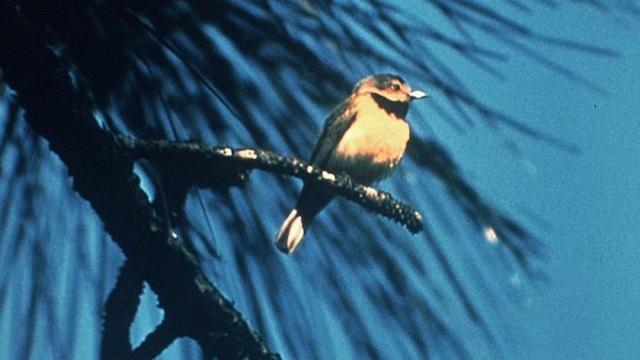The U.S. is officially saying goodbye to 21 species that have been feared gone for years. These animals, which include many birds and marine mammals, have been delisted from the Endangered Species Act because they are now declared extinct, the U.S. Fish and Wildlife Service said this week. One famous bird, the ivory-billed woodpecker, was meant to be included in this delisting but has been given another chance, as a group of dedicated birders wage an improbable fight to prove that it may still exist in the American south.
You can see the full list of now-officially-extinct creatures here. It includes one mammal, the Little Mariana fruit bat from Guam. There are 10 birds on the list, including the Molokai creeper, the Large Kauai thrush, and the Kauai akialoa. Most of the birds on the list called Hawaii home; two others were from Florida and Guam. The San Marcos gambusia and the Scioto madtom are the two fish, and the rest of the creatures are freshwater mussels, most of which were native to Gulf states.
The FWS proposed that these species be taken off the endangered list back in 2021. One of the bird species had not been seen since 1899, while another was spotted as recently as 2004.
“Federal protection came too late to reverse these species’ decline, and it’s a wake-up call on the importance of conserving imperilled species before it’s too late,” FWS Director Martha Williams said in this week’s announcement. “As we commemorate 50 years of the Endangered Species Act this year, we are reminded of the Act’s purpose to be a safety net that stops the journey toward extinction. The ultimate goal is to recover these species, so they no longer need the Act’s protection.”
When native species are endangered or become extinct, it’s a blaring alarm that an ecosystem is not doing well. Some species die out because they lose their natural environment to human activity, like urban development. In other cases, devastating environmental changes are brought on by the climate crisis.
Some plants and animals are pushed out by invasive species that prey on native wildlife or take up their resources. For example, Hawaiian honeycreepers were wiped out by habitat loss and diseases spread by non-native mosquitoes, NPR reported.
For those not ready to give up hope, there are recorded instances of ‘extinct’ creatures being found alive again. These Lazarus species make for thrilling stories, but unfortunately, the vast majority of delisted species truly are gone for good.
